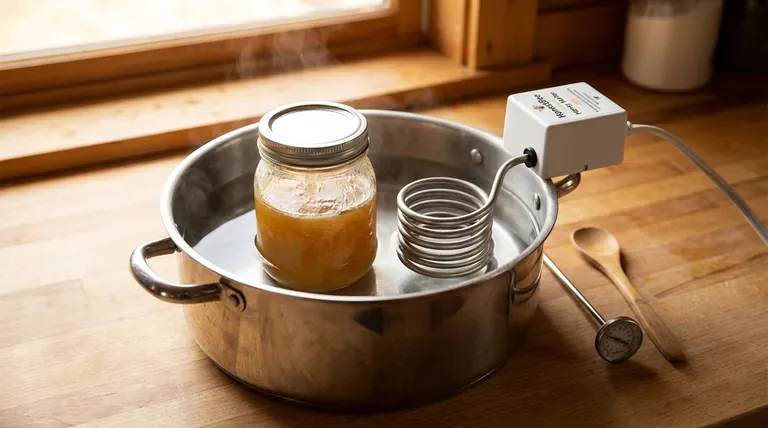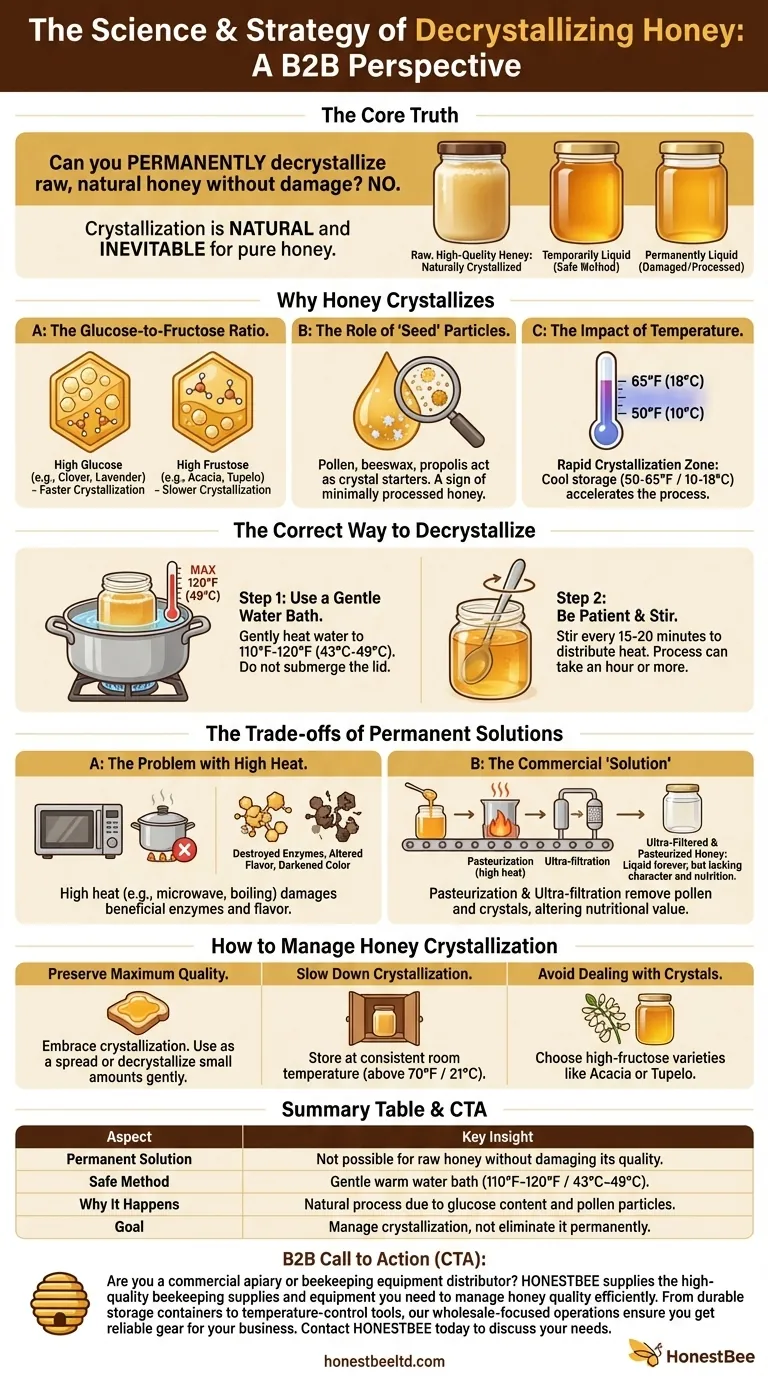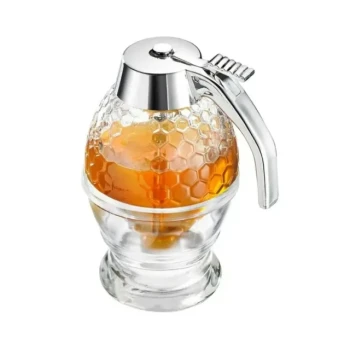It is not possible to permanently decrystallize raw, natural honey without damaging it. Crystallization is an inevitable and natural process for pure honey. You can, however, safely return it to a liquid state temporarily by placing the jar in a warm water bath heated to around 110°F to 120°F (43°C to 49°C), stirring gently until the crystals dissolve.
The core issue is a misunderstanding of what crystallization represents. Instead of viewing it as a flaw to be eliminated, you should see it as a mark of high-quality, unprocessed honey. The goal is not to prevent it permanently, but to manage it gently.

Why Honey Crystallizes in the First Place
Understanding the "why" behind crystallization is the key to managing your honey correctly. It is not a sign of spoilage or poor quality; quite the opposite.
The Glucose-to-Fructose Ratio
Honey is primarily a supersaturated solution of two sugars: glucose and fructose.
Glucose is significantly less soluble in water than fructose. When the glucose separates from the water, it forms small crystals, which then trigger a chain reaction.
Honeys with a higher glucose content (like clover, lavender, or dandelion) will crystallize much faster than those with a higher fructose content (like acacia or tupelo).
The Role of "Seed" Particles
Tiny particles of pollen, beeswax, and propolis suspended in raw honey act as starting points, or "seeds," for crystals to form around.
The presence of these particles is a hallmark of minimally processed, natural honey. Commercially processed honey is often ultra-filtered to remove them, which is one reason it stays liquid longer.
The Impact of Temperature
Crystallization happens most rapidly at temperatures between 50°F and 65°F (10°C to 18°C).
This is why storing honey in a cool pantry or cabinet can often accelerate the process, while room temperature storage can slow it down.
The Correct Way to Decrystallize Honey
The only goal when decrystallizing honey is to dissolve the glucose crystals without damaging the delicate enzymes and aromatic compounds that make it unique.
Use a Gentle Water Bath
Place your glass jar of honey into a pot of water. Do not let the water level rise above the lid.
Gently heat the water on the stove over low heat. Use a thermometer to ensure the water does not exceed 120°F (49°C).
Be Patient and Stir Occasionally
This process is slow. Depending on the size of the jar and the extent of crystallization, it may take an hour or more.
Stirring the honey every 15-20 minutes will help distribute the heat and speed up the process of dissolving the crystals. Once liquid, remove it from the heat.
Understanding the Trade-offs
Seeking a permanent solution often leads to methods that destroy the very qualities that make raw honey valuable.
The Problem with High Heat
Using a microwave or boiling water will decrystallize honey very quickly, but this aggressive heat will destroy beneficial enzymes like diastase and invertase.
High heat also fundamentally alters the flavor and can darken the honey's color, essentially "cooking" it and eliminating its nuanced floral notes.
The Commercial "Solution"
Large-scale honey producers use pasteurization (high-heat treatment) and ultra-filtration to create a product that remains liquid on the shelf almost indefinitely.
This process removes all pollen and crystals, but it also removes much of the honey's unique character and nutritional value. The resulting product is more of a generic sweetener than a natural food.
How to Manage Honey Crystallization
Your strategy should depend on your primary goal.
- If your primary focus is to preserve maximum quality: Embrace crystallization. Use the honey in its solid, creamy state as a spread, or decrystallize only small amounts as needed using the gentle water bath method.
- If your primary focus is to slow down crystallization: Store your honey in a sealed container at a consistent room temperature (above 70°F / 21°C). Avoid storing it in cool pantries or the refrigerator.
- If your primary focus is to avoid dealing with crystals: Purchase honey varieties that are naturally high in fructose, such as acacia or tupelo honey, as they can remain liquid for years.
Ultimately, learning to manage crystallization is learning to appreciate honey in its most natural and beneficial state.
Summary Table:
| Aspect | Key Insight |
|---|---|
| Permanent Solution | Not possible for raw honey without damaging its quality. |
| Safe Method | Gentle warm water bath (110°F-120°F / 43°C-49°C). |
| Why It Happens | Natural process due to glucose content and pollen particles. |
| Goal | Manage crystallization, not eliminate it permanently. |
Are you a commercial apiary or beekeeping equipment distributor? HONESTBEE supplies the high-quality beekeeping supplies and equipment you need to manage honey quality efficiently. From durable storage containers to temperature-control tools, our wholesale-focused operations ensure you get reliable gear for your business. Contact HONESTBEE today to discuss your needs and discover how we can support your operation's success.
Visual Guide

Related Products
- Professional Thermostatic Conical Honey Melter
- Honey Concentrating Vacuum Heating Thickening Machine Dehumidifier for Honey
- 0.5T Capacity Honey Dehumidifier Dryer with Vacuum Heating and Thickening Filtering Machine
- High Quality Honey Dehumidifier Dryer Thickening Machine for Beekeeping
- 10L Stainless Steel Electric Honey Press Machine
People Also Ask
- What equipment is commonly used for heating and processing honey? Essential Tools for Every Beekeeper
- Is it safe to heat crystallized honey? Restore Your Honey's Liquid State Safely
- What is melter honey used for? A Low-Cost Ingredient for Bakers and Brewers
- Why is heating honey sometimes necessary? The Essential Guide to Processing & Quality
- What are the negative effects of overheating honey? Preserve Your Honey's Natural Quality



















